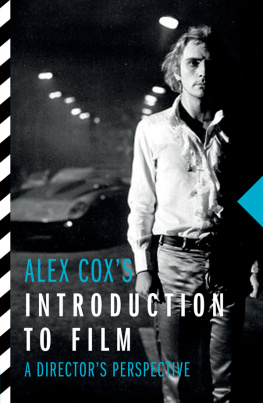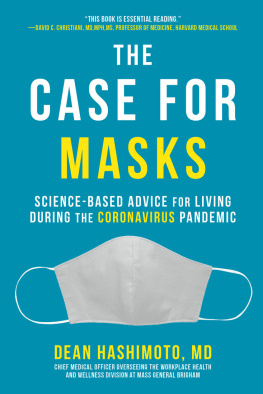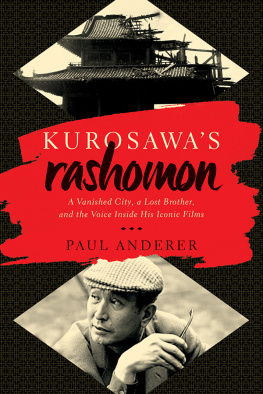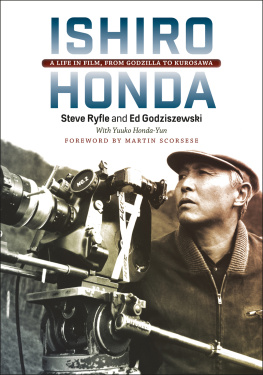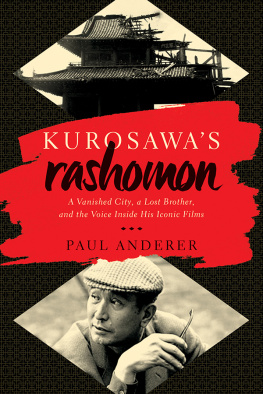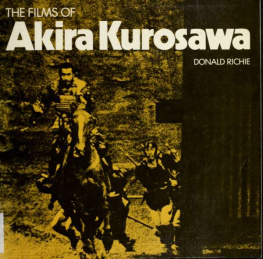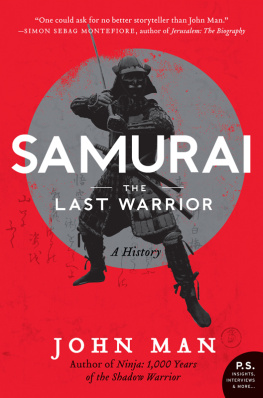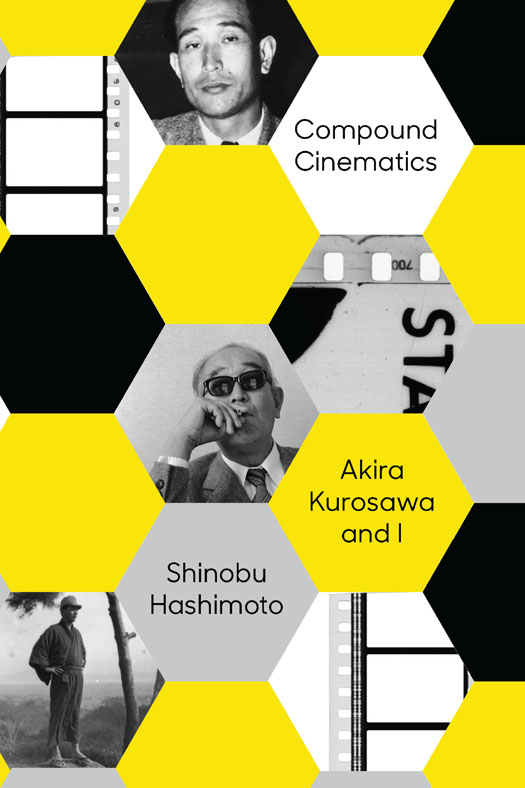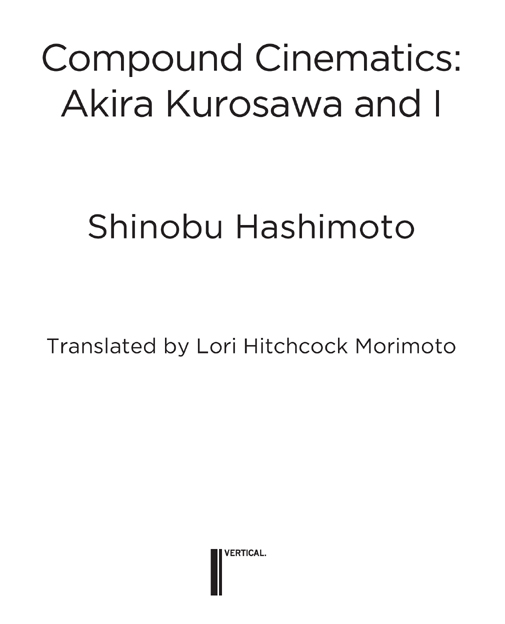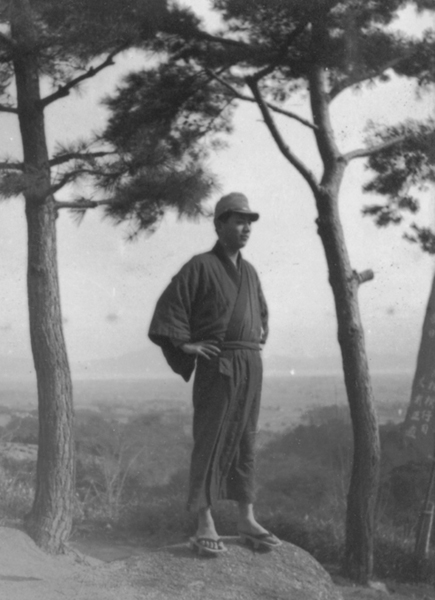Jacket photo of Akira Kurosawa Roger Ressmeyer/CORBIS
Rashomon KADOKAWA 1950
Motion picture Ikiru 1952 Toho Co., Ltd. All Rights Reserved.
Motion picture Seven Samurai 1954 Toho Co., Ltd. All Rights Reserved.
This publication is not sponsored or otherwise endorsed by Toho Co., Ltd.
FUKUGAN NO EIZO Watashi to Kurosawa Akira
by HASHIMOTO Shinobu
Copyright 2006 HASHIMOTO Shinobu
All rights reserved.
Original Japanese edition published by Bungeishunju Ltd., Japan
English translation rights reserved by Vertical, Inc., U.S.A., under the license granted by HASHIMOTO Shinobu, Japan arranged with Bungeishunju Ltd., Japan
Published by Vertical, Inc., New York, 2015
e-ISBN 978-1-939130-58-7
Vertical, Inc.
451 Park Avenue South, 7th Floor
New York, NY 10016
www.vertical-inc.com
v3.1
PROLOGUE: TOKYO MARCH
Shall we to the cinema? Shall we tea?
Perhaps run away on the Odakyu?
Changing Shinjuku, that
I was born and raised in the countryside in Hyogo Prefecture in the Kansai region.
My first awareness that a private rail line by the name of Odakyu existed in metropolitan Tokyo came not through my employment with the Japan National Railway (as JR was once known), but by way of the light, lively melody of a popular song from 1929 or 1930, Tokyo March (lyrics by Yaso Saijo, music by Shimpei Nakayama), each line of which was a conductors announcement, an information board telling me of a Tokyo on which I had yet to set eyes.
But when I finally saw Tokyo with my own eyes more than ten years later, it wasnt the Maru Building of love, Urbane Asakusa, or Changing Shinjuku of the songs lyrics, but a desolate, burnt-out wasteland.
I enlisted for active duty with the Tottori army regiment in 1938, but tuberculosis resulted in my discharge and, after army and Red Cross hospitals and four years spent in a disabled veterans rehabilitation facility, I eventually regained my freedom. I couldnt return to my job at the National Railway with such a blow to my body, however, and I became a salaryman at a munitions company and there welcomed the end of the war. Immediately afterwards, I was dispatched to Tokyo on business, and so it was that I set foot for the first time on the soil I had so yearned after.
My destination was the annex of Isetan Department Store in Shinjuku, where the Ministry of Munitionssimilar to todays Ministry of Economy, Trade and Industrywas headquartered. The elevator was out of service, so I laboriously climbed the staircase to the sixth floor, stopping now and then on a landing to catch my breath, surveying the burnt ruins of Tokyo that stretched out under a clear blue sky as far as the eye could see. I found myself wondering if this Isetan might have been the department store of the Tokyo March lyrics: Changing Shinjuku, that Musashino / moon shines over your department stores
Shortly thereafter, my company opened a branch office on Showa Street near Okachimachi Station in Taito Ward that served as a foothold for all of my subsequent business trips.
Theres a line in Tokyo March that goes, Big Tokyo, cramped for lovers, and, indeed, even I had one acquaintance in Tokyo: Kiyoshi Saeki, a filmmaker at Shin-Toho. Mr. Saeki had been an assistant director under my screenwriting mentor, Mansaku Itami, and together they had departed Uzumasa, Kyotos JO (a studio) to work at Toho in Tokyo. When Mr. Itami was invalided with tuberculosis a few years later, he went to work for Daiei to return to a familiar life in Kyoto, but Mr. Saeki remained at Toho and, when Shin-Toho was established, he was promoted to the position of director.
Mr. Saeki lived at Karasuyama in Setagaya Ward. Taking the Yamanote Line from Okachimachi to Kanda, the Chuo Line to Shinjuku, and transferring to the Keio Line for Chitose Karasuyama, or opting for the Yamanote Line to Shibuya, the Inogashira Line to Meidai-mae, and transferring from there to the Keio Line, I often visited him (those of us who were close to Mr. Itami called Mr. Saeki Saeki-niisan [big brother Saeki], while others referred to the rising filmmaker as Saeki no anchan [bro in the non-related sense]). And so it was that I spent a considerable amount of time riding the Keio and Inogashira Lines on my trips to and from Mr. Saekis home but never once took the Odakyu.
It was early spring in 1949.
Over the houses along Showa Street growled the last winds of winter, the gusts blowing from the direction of Ueno awfully biting.
Wearing an overcoat and carrying a briefcase, I headed out from the Tokyo branch office of my company and took the outer loop of the Yamanote Line from Okachimachi. I got off at Shibuya and transferred to the Inogashira Line. Just before arriving at Shimokitazawa, along the intersecting line under the elevated bridge an outbound Odakyu train passed by like a stranger, its broad top leaving an impression on me.
Getting off at Shimokitazawa, and after much glancing about and the help of an information board, I descended to the Odakyu platform and waited to board the next outbound train. This was my first time on the Odakyu. I was headed for Komae, two stops after Seijo Gakuen, and the home of a Mr. Kurosawa, in Komae along the Odakyu the film director Akira Kurosawa, on whom I was paying a call.
It had been decided that Mr. Kurosawa would film my script Shiyu (Male and Female, later retitled Rashomon), and the producer, Mr. Sojiro Motoki, wanted me to meet Mr. Kurosawa. Today would be our first face-to-face, our first planning session.
What kind of person was Mr. Kurosawa? It wasnt as though I didnt have some sense that this might be a fateful meeting, but I wouldnt know until I met him. Either way, it didnt do to dwell on it, so I just turned my attention to the scenery racing past the window of the Odakyu train.
Vacant plot, crop patch, grove, house, housethe air raids hadnt left many scars along this routecrossing, station, shopping street, apartment building, vegetable field, harvested black rice field, house, house, vacant plot, crossing, another new apartment building Endlessly sprawling out as far as I could see, house, house, house A vague something was niggling at the back of my mind, gradually coming clear. Big Tokyo, cramped for lovers, urbane Asakusa As I looked out at the scenery through the windows of the first Odakyu train I ever rode, a song that had been popular over twenty years earlier played over and over like a tape recording in the back of my mind. Tokyo March.
Shall we to the cinema? Shall we tea?
Perhaps run away on the Odakyu?
Changing Shinjuku, that Musashino
CHAPTER ONE: THE BIRTH OF RASHOMON
The author at the time of his admission to the Okayama Disabled Veterans Rehabilitation Facility circa 1941.
My Comrade at the Disabled Veterans Rehabilitation Facility
It was great luck surpassing coincidence, eventuality, or even inexorable fate that brought Mansaku Itami-sensei and me together.
It was a hot day. Even now, I cannot forget the searing heat of that day.
The Okayama Disabled Veterans Rehabilitation Facility was located in Hayashima, Tsukubo County in Okayama Prefecture, near where the Kojima Peninsula juts out into the Seto Inland Sea. It occupied forty-eight acres over a string of low mountains, and on this hilly terrain the hospital wards sat on red pine-covered rises on the east and west sides, with the main building between them, and open-air huts and the like on the west peak. As a tuberculosis sanatorium administered by the Ministry of Health and Welfare, it was open to navy and army officers and enlisted men who had become symptomatic during their military service.


